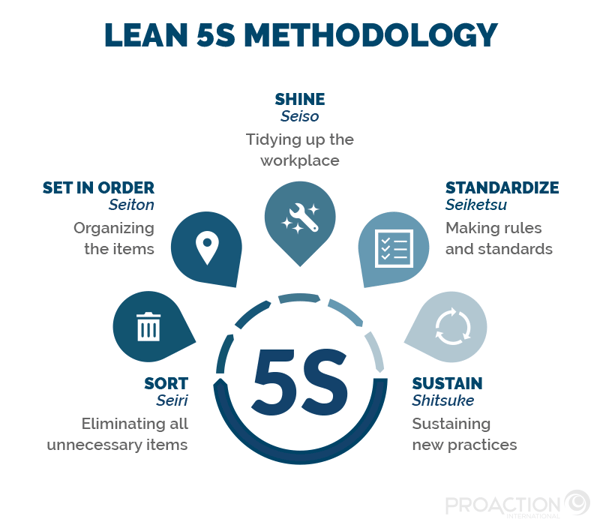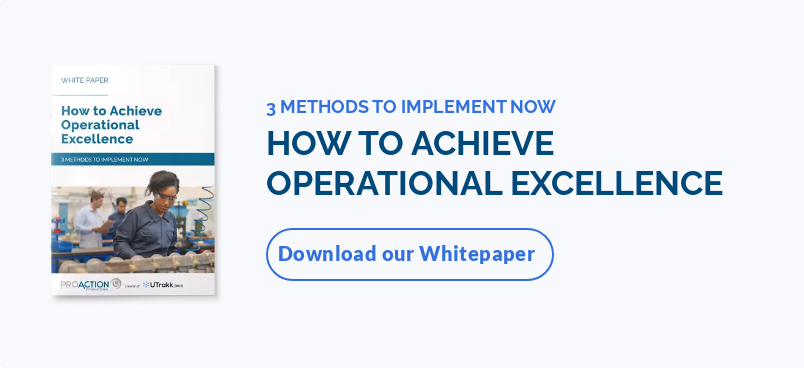The origin of the 5S methodology
The 5S methodology began as part of the Toyota Production System – a "Just-In-Time" manufacturing system focused on eliminating all waste in the pursuit of the most efficient work processes. This type of manufacturing method intends to only produce the amount of product needed, when it is needed.
Initially, the Toyota Production System was a closely-guarded secret, but the massive economic boom post-war Japan experienced in the 1980s drew massive interest from foreign corporations. They were wondering how Toyota Motor Company, the leading manufacturer in Japan, was able to produce so many products so quickly, and with such a high quality.
However, it was not until a few years later that the 5 pillars of the visual workplace were defined by Hiroyuki Hirano, a concept that would transform into the 5S methodology we know today.
Saying that the 5S has gained massive traction over the years would be an understatement. Today, this organizational system is widely considered one of the foundational elements of Lean Manufacturing and has spreaded to the modern workplace.
Besides 5S, many tools in Lean Manufacturing have been adopted by other industries, like technology, including:
What is 5S?
Simply put, 5S is a systematic approach to workplace organization. Part of the Lean Manufacturing umbrella, 5S is designed to improve efficiency, eliminate waste, and maximize productivity through visual management, also known as visual control.
There are 5 sequential steps in the 5S system. Each "S" stands for a Japanese word that describes what the step means and what should be done.
The 5S principles

- Seiri – Sort: The process of sorting what is needed and not needed in the workplace. If something is not important to your operating procedures, don't let it take space or create confusion.
- Seiton – Set in order: The process of keeping the workplace organized by neatly arranging and identifying parts and tools. This step can be summarized by the following sentence: "A place for everything and everything in its place."
- Seiso – Shine: This process involves tidying up the workplace. "Seiso" means cleaning and inspecting the work environment regularly, including the tools, products, and machinery.
- Seiketsu – Standardize: This section standardizes the processes above – Sort, Set in order, and Shine. In essence, this is where you take the first 3 S's and make rules for how and when these tasks will be performed.
- Shitsuke – Sustain: This involves sustaining new work practices and conducting audits to maintain discipline throughout the cycle. The goal is to continuously improve.
These steps must be executed in this exact order, as the next one always depends on the previous one. Here's how:
- Eliminating all unnecessary items in step 1 (Sort) will provide the space needed to organize the items in step 2 (Set in order).
- Once the workplace is visually organized, grime, dirt, and other stains can be removed in step 3 (Shine).
- Changes to employees' job duties and workstations should be documented and standardized through step 4 (Standardize). This ensures everyone complies with the processes, procedures, and rules in place.
- Lastly, compliance and discipline should be applied, and progress tracked consistently, per step 5 (Sustain).
With rigorous discipline, defined objectives, and a clear view of the work environment, each employee will be part of the cycle, always returning to step 1 for continuous improvement.
Pro tip: Structured follow-up through active supervision tours is an effective way of creating a successful continuous improvement process.
Is there a 6th "S" in the 5S methodology?
In recent years, there's been some debate on whether or not a sixth "S" – Safety – should be introduced. Some argue that safety is an integral part of the 5S method, while others suggest that the link connecting the concepts is very thin.
Regardless, safety is one of the main concerns and lean performance indicators in manufacturing organizations and should be part of every operational excellence program, lean or not.
What are the benefits of 5S?
The 5S methodology brings many benefits for manufacturers, including:
1. Improved quality
With the implementation of 5S, there is a designated place for everything that is needed in the workplace. All the items fit in their own space and are clearly identified.
This minimizes errors in the use and handling of material, as well as wastage due to waiting, unnecessary motion, and transportation.
With the right material that is where it should be, the quality of work improves.
2. Heightened safety
Without clutter, any and all kind of hazardous materials and conditions become visible.
With 5S, what you get is an ergonomic layout that prevents dangerous movements often leading to "slip and fall" injuries, improving safety and health in the workplace.
3. Improved morale and employee engagement
Implementing formal processes and procedures and encouraging compliance in the workplace help perpetuate best practices and improvement efforts.
When everyone is involved in defining, applying, and enforcing processes and procedures, this can create a sense of purpose and improved job satisfaction, which leads to higher morale and increased engagement among employees.
4. Better equipment management
A clear and organized workplace with proper labeling helps workers replace damaged items in designated places. This significantly minimizes the number of lost tools, products, and equipment.
Proper management of equipment also reduces damages that could occur to a product during the manufacturing process.
5. Increased productivity
As mentioned above, the 5S methodology minimizes any kind of waste – tools, material, machinery, equipment, transportation, etc. – all while standardizing processes and systems.
This helps improve productivity, increase availability, and overall profitability.
6. Higher efficiency
With 5S, employees and managers have a clear view of what equipment they should use when, and how.
They can seamlessly store frequently used items closer to the production floor, order missing equipment in advance, and integrate predictive maintenance to prevent machine breakdown and associated interruptions.
How to implement 5S
In this section, we're diving into the steps required to implement 5S within your organization.
1. Seiri – Sort
At the Seiri stage, we recommand using the "red tag method" – a tried-and-tested strategy to identify potentially unnecessary items in the workplace, evaluate their viability, and address them appropriately.
Ask yourself these questions when sorting any item in the work area:
- Is this item really necessary?
- If necessary, do you need this amount?
- If necessary, must it be located here?
Once you have answered these questions, take action:
- Keep items in a "red tag" area for a specific time to see if they are necessary.
- Discard them.
- Change their location.
- Leave them at the same place.
2. Seiton – Set in order
At this step, you need to ensure everything is in its place and available to all employees.
"Set in order" is about finding the best place for each item in the workplace, taking into account frequency of use and space requirements. For example, a small item used frequently must be within reach at appropriate workstations.
3. Seiso – Shine
The third S means keeping the workplace safe and free of health hazards (think spilled chemicals, dust, etc.). Proper cleaning procedures must be followed.
Here's how you can implement this step:
- Identify what needs to be cleaned up.
- Turn specific work areas into "cleaning areas" and assign people to these workstations.
- Define the cleaning process: who, where, when, how, and what.
- Store the cleaning supplies and tools, keeping them in areas where they are easy to access, use, and return.
- Incorporate a short yet rigorous cleaning inspection.
4. Seiketsu – Standardize
To establish clear visual standards when implementing the Standardize step:
- Identify the location of each item, using visual tools such as floor marking tape, shadow boards, red tags, color coding, and labels.
- Identify all items and their needed quantity.
5. Shitsuke – Sustain
To make a habit of maintaining the correct work, safety, and health procedures, you must:
- Assign a person in charge of maintaining the right conditions for sustainable Sort, Set in order, and Shine steps.
- Integrate a daily maintenance schedule to avoid interruptions and obstacles.
- Monitor maintenance activities at your facility.
- Use 5S slogans, newsletters, posters, or visual boards for every team member to keep 5S principles top of mind.
You might want to consider benchmarking your initiatives against other companies (or departments). This will help you know what you're doing right, what can be improved, and what else can be done to make your 5S implementation a lasting success.
Tips for a sustainable 5S system in the workplace
1. Commit to operational excellence
Efforts must be made to sustain the initial improvements, avoid non-compliance with standards, and stay focused on operational excellence. The team leaders and frontline managers play a crucial role in institutionalizing 5S so that it becomes a way of work.
They can achieve this through frequent active supervision tours, backed by a robust daily management system (DMS) like UTrakk.
2. Ensure support from top management
Commitment will remain an illusion if the top management fails to support the program. As such, senior management needs to have a clear understanding of the benefits of 5S and align them with the overarching business strategy.
That's the only way to achieve consistent success with the 5S Lean Manufacturing tool.
3. Measure performance (and recognize successes)
A third tip is to measure 5S performance in each work area. This should entail setting up an honest and fair system to reward teams that nail down a successful 5S strategy.
Measuring the performance of lean production tools such as 5S can be done using Gemba Walk checklists, active supervision tours, and score sheets built-in our DMS.
Display performance results in public areas to create a sense of self-belief and confidence among workers. This can encourage teams to improve continuously, through 5S standards and procedures that are always refreshed, optimized, and up-to-date.
Next step: Implementing 5S in your organization
Who said 5S implementation has to be a time-consuming, strenuous, and energy-draining endeavor? Proaction International's consultants can help you craft a 5S strategy that is geared toward operational excellence.
As experts in Lean Manufacturing, we can guide you in your 5S implementation project with a clear action plan backed by highly efficient tools, cutting-edge management processes, robust communication procedures, and a continuous improvement culture.




.webp)





